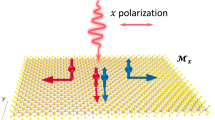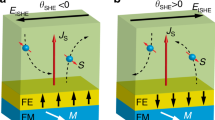Abstract
The photo-voltaic effect typically occurs in semiconductors and involves photon-driven excitation of electrons from a valence band to a conduction band. In a region such as a p–n junction that has a built-in electric field, the excited electrons and holes diffuse in opposite directions, resulting in an electric voltage. This letter reports that a spin voltage can be created by photons in a non-magnetic metal that is in close proximity to a magnetic insulator: a photo-spin-voltaic effect. The experiments use platinum/magnetic insulator bilayer structures. On exposure to light, there occurs photon-driven, spin-dependent excitation of electrons in several platinum atomic layers near the platinum/magnetic insulator interface. The excited electrons and holes diffuse in different manners, and this gives rise to an effective spin voltage at the interface and a corresponding pure spin current that flows across the platinum.
This is a preview of subscription content, access via your institution
Access options
Subscribe to this journal
Receive 12 print issues and online access
$209.00 per year
only $17.42 per issue
Buy this article
- Purchase on Springer Link
- Instant access to full article PDF
Prices may be subject to local taxes which are calculated during checkout






Similar content being viewed by others
References
Urban, R., Woltersdorf, G. & Heinrich, B. Gilbert damping in single and multilayer ultrathin films: role of interfaces in nonlocal spin dynamics. Phys. Rev. Lett. 87, 217204 (2001).
Mizukami, S., Ando, Y. & Miyazaki, T. Effect of spin diffusion on Gilbert damping for a very thin permalloy layer in Cu/permalloy/Cu/Pt films. Phys. Rev. B 66, 104413 (2002).
Tserkovnyak, Y., Brataas, A. & Bauer, G. E. W. Enhanced Gilbert damping in thin ferromagnetic films. Phys. Rev. Lett. 88, 117601 (2002).
Uchida, K. et al. Observation of the spin Seebeck effect. Nature 455, 778–781 (2008).
Uchida, K. et al. Spin-Seebeck effects in Ni81Fe19/Pt films. Solid State Commun. 150, 524–528 (2010).
Jaworski, C. et al. Observation of the spin-Seebeck effect in a ferromagnetic semiconductor. Nature Mater. 9, 898–903 (2010).
Jaworski, C. et al. Spin-Seebeck effect: a phonon driven spin distribution. Phys. Rev. Lett. 106, 186601 (2011).
Jaworski, C., Myers, R., Johnston-Halperin, E. & Heremans, J. Giant spin Seebeck effect in a non-magnetic material. Nature 487, 210–213 (2012).
Uchida, K. et al. Spin Seebeck insulator. Nature Mater. 9, 894–897 (2010).
Qu, D., Huang, S. Y., Hu, J., Wu, R. & Chien, C. L. Intrinsic spin Seebeck effect in Au/YIG. Phys. Rev. Lett. 110, 067206 (2013).
Dyakonov, M. I. & Perel, V. I. Possibility of orienting electron spins with current. JETP Lett. 13, 467–469 (1971).
Hirsch, J. E. Spin Hall effect. Phys. Rev. Lett. 83, 1834–1837 (1999).
Day, C. Two groups observe the Spin Hall effect in semiconductors. Phys. Today 58, 17–19 (February, 2005).
Hoffmann, A. Spin Hall effects in metals. IEEE Trans. Magn. 49, 5172–5193 (2013).
Sun, Y. & Wu, M. in Solid State Physics Vol. 64 (eds Wu, M. & Hoffmann, A.) (Academic, 2013).
Wu, M. in Advanced Magnetic Materials (ed. Malkinski, L.) (InTech, 2012).
Valenzuela, S. O. & Tinkham, M. Direct electronic measurement of the spin Hall effect. Nature 442, 176–179 (2006).
Kittel, C. Introduction to Solid State Physics 8th edn (John Wiley, 2005).
DiSalvo, F. J. Thermoelectric cooling and power generation. Science 285, 703–706 (1999).
Huebener, R. P. & Seher, A. Nernst effect and flux flow in superconductors. I. Niobium. Phys. Rev. 181, 701–709 (1969).
Pu, Y., Johnston-Halperin, E., Awschalom, D. D. & Shi, J. Anisotropic thermopower and planar Nernst effect in Ga1−xMnxAs ferromagnetic semiconductors. Phys. Rev. Lett. 97, 036601 (2006).
Huang, S. Y., Wang, W. G., Lee, S. F., Kwo, J. & Chien, C. L. Intrinsic spin-dependent thermal transport. Phys. Rev. Lett. 107, 216604 (2011).
Ky, V. D. The planar Nernst effect in permalloy films. Phys. Status Solidi B 17, K207–K209 (1966).
Avery, A. D., Pufall, M. R. & Zink, B. L. Observation of the planar Nernst effect in permalloy and nickel thin films with in-plane thermal gradients. Phys. Rev. Lett. 109, 196602 (2012).
Yin, S. L., Mao, Q., Meng, Q. Y., Li, D. & Zhao, H. W. Hybrid anomalous and planar Nernst effect in permalloy thin films. Phys. Rev. B 88, 064410 (2013).
Kehlberger, A. et al. Length scale of the spin Seebeck effect. Phys. Rev. Lett. 115, 096602 (2015).
Jakubisova-Liskova, E., Visnovsky, S., Chang, H. & Wu, M. Optical spectroscopy of sputtered nanometer-thick yttrium iron garnet films. J. Appl. Phys. 117, 17B702 (2015).
Hughes, J. L. P. & Sipe, J. E. Calculation of second-order optical response in semiconductors. Phys. Rev. B 53, 10751–10763 (1996).
Huang, S. Y. et al. Transport magnetic proximity effects in platinum. Phys. Rev. Lett. 109, 107204 (2012).
Lu, Y. M. et al. Pt magnetic polarization on Y3Fe5O12 and magnetotransport characteristics. Phys. Rev. Lett. 110, 147207 (2013).
Zhou, X. et al. Tuning magnetotransport in PdPt/Y3Fe5O12: effects of magnetic proximity and spin-orbit coupling. Appl. Phys. Lett. 105, 012408 (2014).
Ganichev, S. D. et al. Spin-galvanic effect. Nature 417, 153–156 (2002).
Leyder, C. et al. Observation of the optical spin Hall effect. Nature Phys. 3, 628–631 (2007).
Miah, M. Observation of the anomalous Hall effect in GaAs. J. Phys. D 40, 1659–1669 (2007).
Wunderlich, J. et al. Spin Hall effect transistor. Science 330, 1801–1804 (2010).
Ando, K. et al. Direct conversion of light-polarization information into electric voltage using photoinduced inverse spin-Hall effect in Pt/GaAs hybrid structure: spin photodetector. J. Appl. Phys. 107, 113902 (2010).
Kampfrath, T. et al. Terahertz spin current pulses controlled by magnetic heterostructures. Nature Nanotech. 8, 256–260 (2013).
Endres, B. et al. Demonstration of the spin solar cell and spin photodiode effect. Nature Commun. 4, 2068 (2013).
Weiler, M. et al. Local charge and spin currents in magnetothermal landscapes. Phys. Rev. Lett. 108, 106602 (2012).
Agrawal, M. et al. Role of bulk-magnon transport in the temporal evolution of the longitudinal spin-Seebeck effect. Phys. Rev. B 89, 224414 (2014).
Li, P. et al. Generation of pure spin currents via spin Seebeck effect in self-biased hexagonal ferrite thin films. Appl. Phys. Lett. 105, 242412 (2014).
Roschewsky, N. et al. Time resolved spin Seebeck effect experiments. Appl. Phys. Lett. 104, 202410 (2014).
Uchida, K. et al. Generation of spin currents by surface plasmon resonance. Nature Commun. 6, 5910 (2015).
Fullerton, E. E. et al. Structure and magnetism of epitaxially strained Pd(001) films on Fe(001): experiment and theory. Phys. Rev. B 51, 6364–6378 (1995).
Bailey, W. E. et al. Pd magnetism induced by indirect interlayer exchange coupling. Phys. Rev. B 86, 144403 (2012).
Wilhelm, F. et al. Systematics of the induced magnetic moments in 5d layers and the violation of the third Hund’s rule. Phys. Rev. Lett. 87, 207202 (2001).
Lang, M. et al. Proximity induced high-temperature magnetic order in topological insulator - ferrimagnetic insulator heterostructure. Nano Lett. 14, 3459–3465 (2014).
Acknowledgements
This work was primarily supported by the US Army Research Office under Award W911NF-14-1-0501. In addition, the fabrication and structural characterization of YIG, YIG/Pt, YIG/Cu and GGG/Pt samples and the DFT calculations were supported by the SHINES, an Energy Frontier Research Center funded by the US Department of Energy, Office of Science, Basic Energy Sciences under Award SC0012670; the fabrication and structural characterization of BaM, BaM/Pt and BaM/Cu samples was supported by the C-SPIN, one of the SRC STARnet Centers sponsored by MARCO and DARPA; and the ferromagnetic resonance and spin pumping measurements were supported by the US National Science Foundation under Award ECCS-1231598. The authors would like to thank J. Sites and J. Raguse of the CSU Photovoltaics Laboratory for helpful discussions regarding optical spectroscopy.
Author information
Authors and Affiliations
Contributions
L.L., D.E. and M.W. conceived the idea and designed the experiments. L.L. established the experimental set-up. D.E. and L.L. performed the measurements and analysed the data. H.C. and P.L. fabricated and characterized the samples. B.J. contributed to the experimental set-up. Y.B. contributed to the measurements. J.L., J.X. and R.W. provided the theoretical model. J.L., Z.W. and J.H. performed the calculations. M.W. supervised the experimental study. R.W. supervised the theoretical study. D.E., J.L., R.W. and M.W. wrote the paper and the Supplementary Information with help from all the other co-authors.
Corresponding authors
Ethics declarations
Competing interests
The authors declare no competing financial interests.
Supplementary information
Supplementary information
Supplementary information (PDF 1174 kb)
Rights and permissions
About this article
Cite this article
Ellsworth, D., Lu, L., Lan, J. et al. Photo-spin-voltaic effect. Nature Phys 12, 861–866 (2016). https://doi.org/10.1038/nphys3738
Received:
Accepted:
Published:
Issue Date:
DOI: https://doi.org/10.1038/nphys3738
This article is cited by
-
Non-Hermitian control between absorption and transparency in perfect zero-reflection magnonics
Nature Communications (2023)
-
High optical spin-filtering in antiferromagnetic stanene nanoribbons induced by band bending and uniaxial strain
Scientific Reports (2023)
-
Spin photogalvanic effect in two-dimensional collinear antiferromagnets
npj Quantum Materials (2021)
-
Optical spin-orbit torque in heavy metal-ferromagnet heterostructures
Nature Communications (2020)
-
Spintronic devices for energy-efficient data storage and energy harvesting
Communications Materials (2020)



